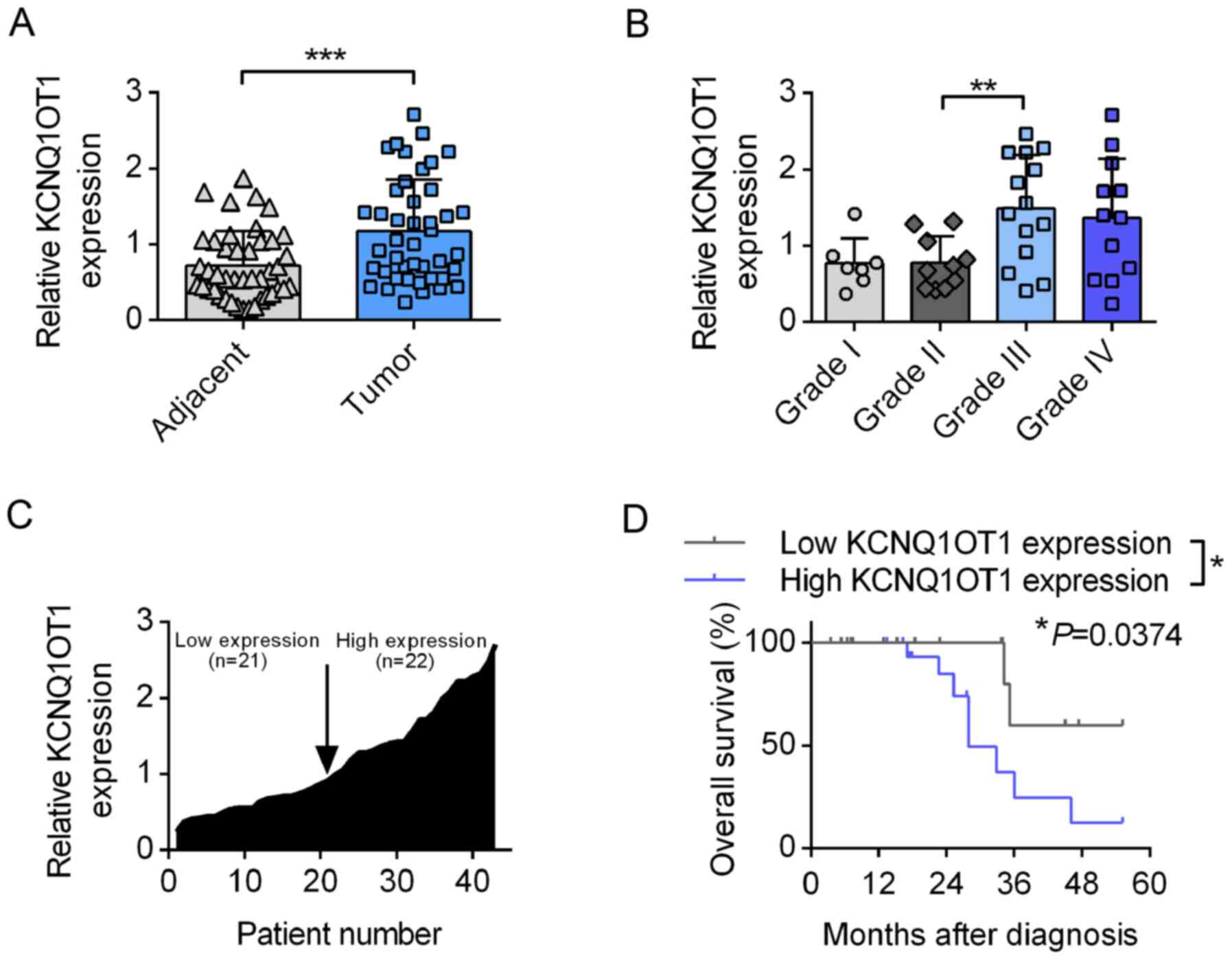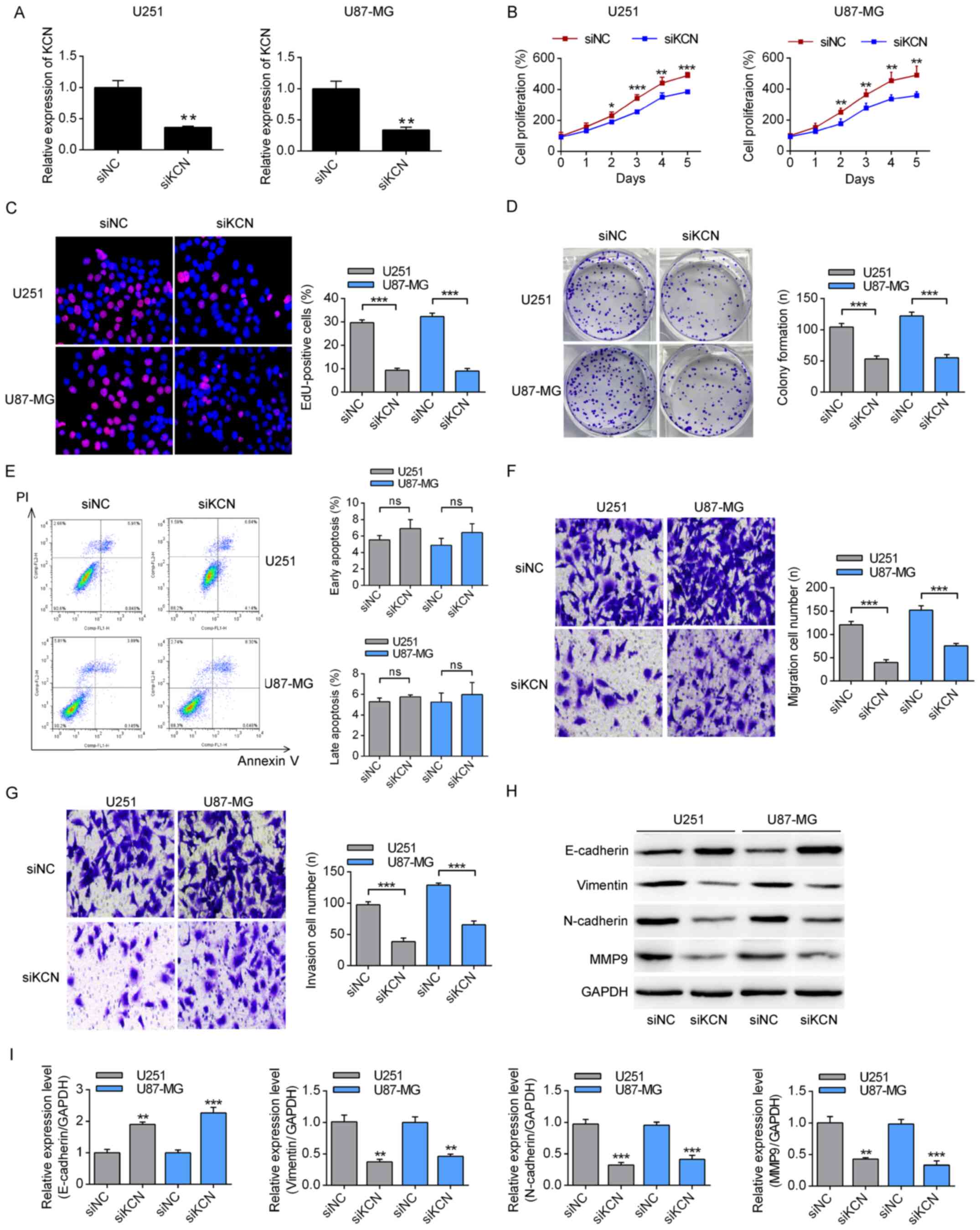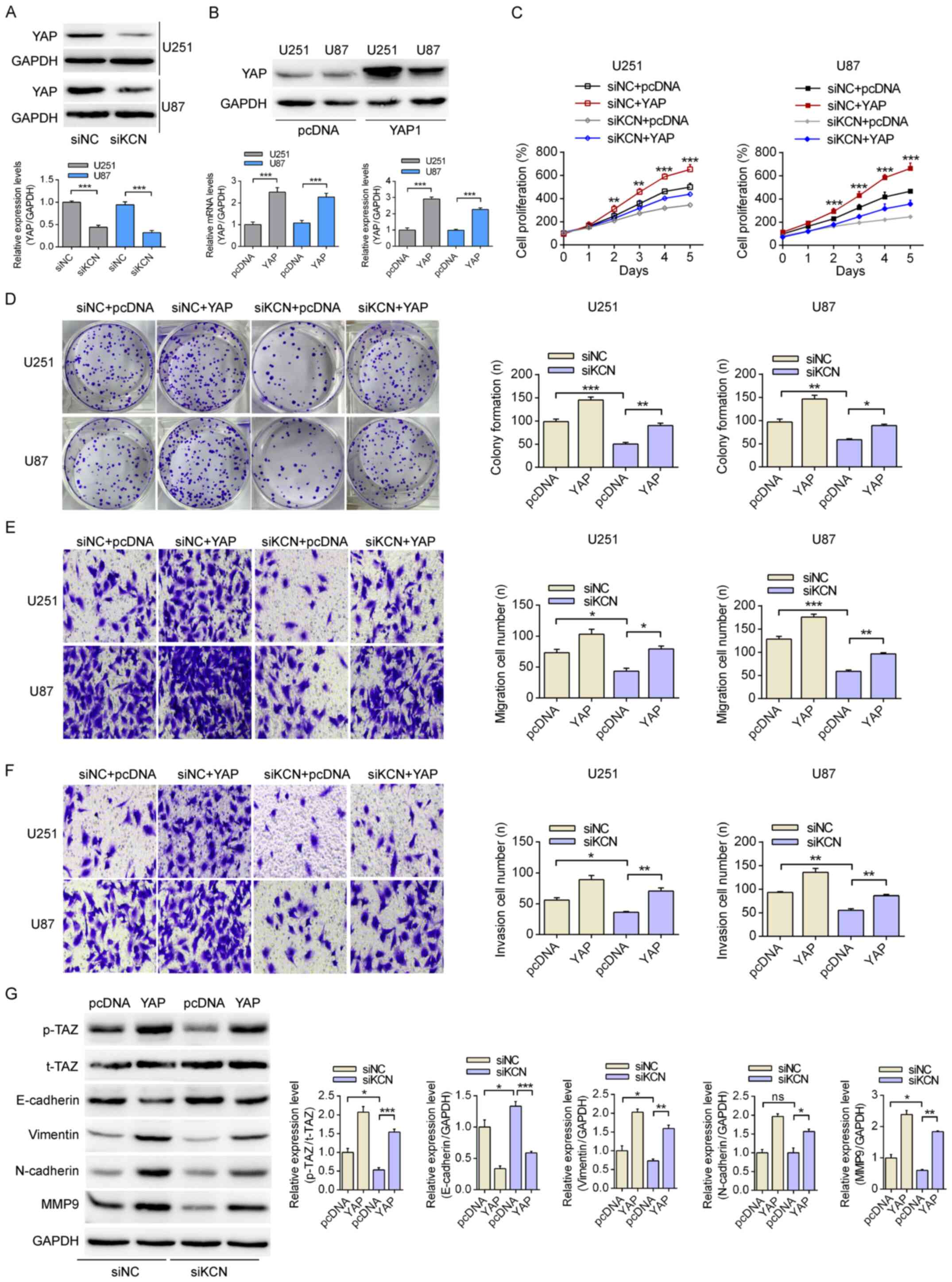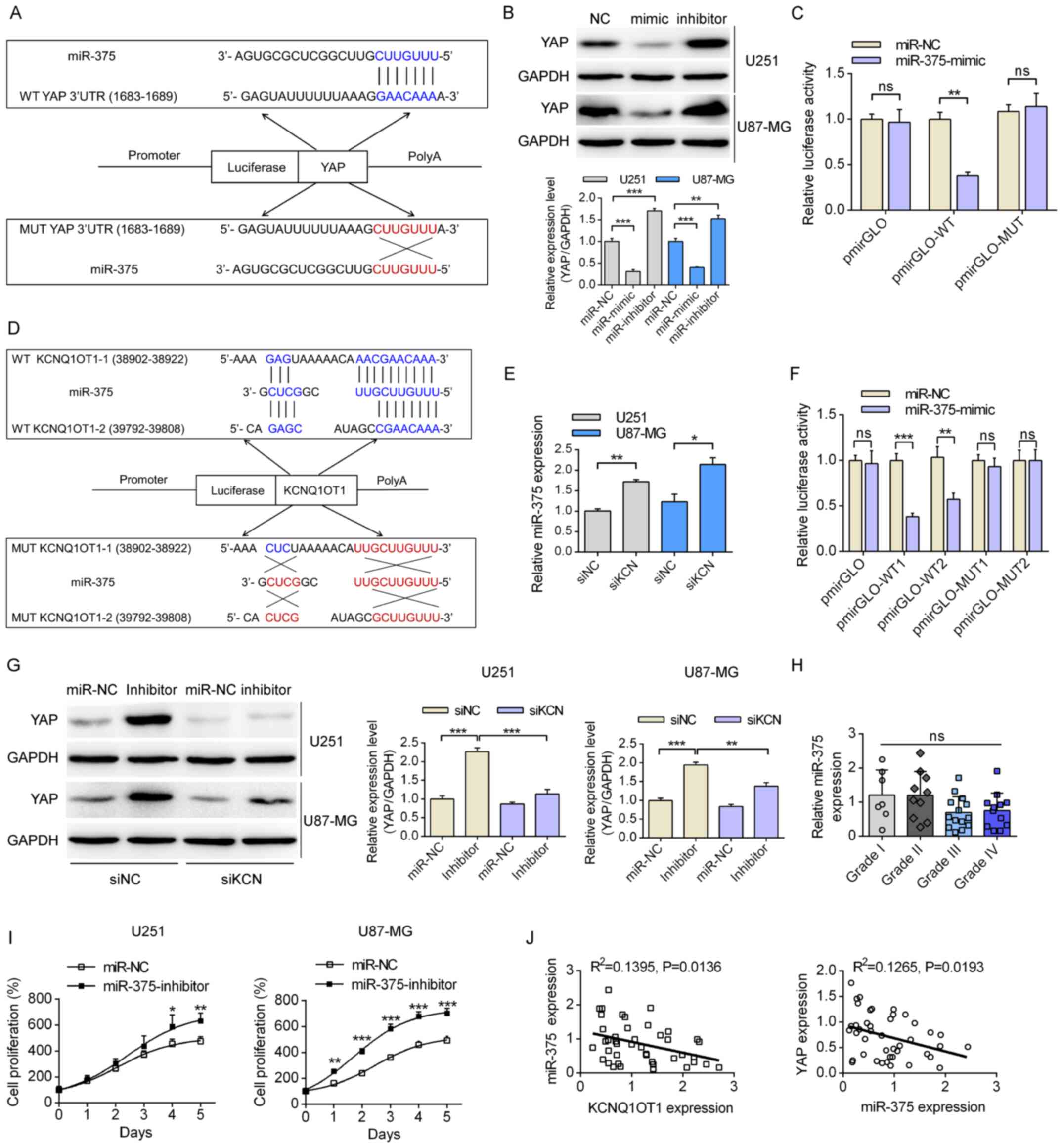|
1
|
Ostrom QT, Gittleman H, Liao P,
Vecchione-Koval T, Wolinsky Y, Kruchko C and Barnholtz-Sloan JS:
CBTRUS Statistical Report: Primary brain and other central nervous
system tumors diagnosed in the United States in 2010-2014. Neuro
Oncol. 19(Suppl 5): v1–v88. 2017. View Article : Google Scholar : PubMed/NCBI
|
|
2
|
Spinelli GP, Miele E, Lo Russo G, Miscusi
M, Codacci-Pisanelli G, Petrozza V, Papa A, Frati L, Della Rocca C,
Gulino A and Tomao S: Chemotherapy and target therapy in the
management of adult high-grade gliomas. Curr Cancer Drug Targets.
12:1016–1031. 2012. View Article : Google Scholar : PubMed/NCBI
|
|
3
|
Van Meir EG, Hadjipanayis CG, Norden AD,
Shu HK, Wen PY and Olson JJ: Exciting new advances in
neuro-oncology: The avenue to a cure for malignant glioma. CA
Cancer J Clin. 60:166–193. 2010. View Article : Google Scholar : PubMed/NCBI
|
|
4
|
Wang J, Su HK, Zhao HF, Chen ZP and To SS:
Progress in the application of molecular biomarkers in gliomas.
Biochem Biophys Res Commun. 465:1–4. 2015. View Article : Google Scholar : PubMed/NCBI
|
|
5
|
Mao H, Lebrun DG, Yang J, Zhu VF and Li M:
Deregulated signaling pathways in glioblastoma multiforme:
Molecular mechanisms and therapeutic targets. Cancer Invest.
30:48–56. 2012. View Article : Google Scholar : PubMed/NCBI
|
|
6
|
Wang KC and Chang HY: Molecular mechanisms
of long noncoding RNAs. Mol Cell. 43:904–914. 2011. View Article : Google Scholar : PubMed/NCBI
|
|
7
|
Lee C and Kikyo N: Strategies to identify
long noncoding RNAs involved in gene regulation. Cell Biosci.
2:372012. View Article : Google Scholar : PubMed/NCBI
|
|
8
|
Balas MM and Johnson AM: Exploring the
mechanisms behind long noncoding RNAs and cancer. Noncoding RNA
Res. 3:108–117. 2018. View Article : Google Scholar : PubMed/NCBI
|
|
9
|
Meng X, Deng Y, Lv Z, Liu C, Guo Z, Li Y,
Liu H, Xie B, Jin Z, Lin F and Zhu H: LncRNA SNHG5 promotes
proliferation of glioma by regulating miR-205-5p/ZEB2 axis. Onco
Targets Ther. 12:11487–11496. 2019. View Article : Google Scholar
|
|
10
|
Ding Y, Wang J, Zhang H and Li H: Long
noncoding RNA-GAS5 attenuates progression of glioma by eliminating
microRNA-10b and Sirtuin 1 in U251 and A172 cells. Biofactors.
46:487–496. 2020. View Article : Google Scholar : PubMed/NCBI
|
|
11
|
Xu H, Zhao G, Zhang Y, Jiang H, Wang W,
Zhao D, Yu H and Qi L: Long non-coding RNA PAXIP1-AS1 facilitates
cell invasion and angiogenesis of glioma by recruiting
transcription factor ETS1 to upregulate KIF14 expression. J Exp
Clin Cancer Res. 38:4862019. View Article : Google Scholar :
|
|
12
|
Huang Z, Zhao X, Wu X, Xiang L, Yuan Y,
Zhou S and Yu W: LncRNA UCA1 facilitated cell growth and invasion
through the miR-206/CLOCK axis in glioma. Cancer Cell Int.
19:3162019. View Article : Google Scholar : PubMed/NCBI
|
|
13
|
Li Y, Li C, Li D, Yang L, Jin J and Zhang
B: lncRNA KCNQ1OT1 enhances the chemoresistance of oxaliplatin in
colon cancer by targeting the miR-34a/ATG4B pathway. Onco Targets
Ther. 12:2649–2660. 2019. View Article : Google Scholar : PubMed/NCBI
|
|
14
|
Feng W, Wang C, Liang C, Yang H, Chen D,
Yu X, Zhao W, Geng D, Li S, Chen Z and Sun M: The dysregulated
expression of KCNQ1OT1 and its interaction with downstream factors
miR-145/CCNE2 in breast cancer cells. Cell Physiol Biochem.
49:432–446. 2018. View Article : Google Scholar : PubMed/NCBI
|
|
15
|
Wang J, Zhang H, Situ J, Li M and Sun H:
KCNQ1OT1 aggravates cell proliferation and migration in bladder
cancer through modulating miR-145-5p/PCBP2 axis. Cancer Cell Int.
19:3252019. View Article : Google Scholar : PubMed/NCBI
|
|
16
|
Kang Y, Jia Y, Wang Q, Zhao Q, Song M, Ni
R and Wang J: Long noncoding RNA KCNQ1OT1 promotes the progression
of non-small cell lung cancer via regulating miR-204-5p/ATG3 axis.
Onco Targets Ther. 12:10787–10797. 2019. View Article : Google Scholar : PubMed/NCBI
|
|
17
|
Luo ZP and Jin H: Effects of LncRNA
KCNQ1OT1 on proliferation and migration of ovarian cancer cells by
Wnt/β-catenin. Eur Rev Med Pharmacol Sci. 23:8788–8794.
2019.PubMed/NCBI
|
|
18
|
Gong W, Zheng J, Liu X, Liu Y, Guo J, Gao
Y, Tao W, Chen J, Li Z, Ma J and Xue Y: Knockdown of long
non-coding RNA KCNQ1OT1 restrained glioma cells' malignancy by
activating miR-370/CCNE2 axis. Front Cell Neurosci. 11:842017.
View Article : Google Scholar : PubMed/NCBI
|
|
19
|
Kalluri R and Weinberg RA: The basics of
epithelial-mesenchymal transition. J Clin Invest. 119:1420–1428.
2009. View
Article : Google Scholar : PubMed/NCBI
|
|
20
|
Ye X and Weinberg RA:
Epithelial-mesenchymal plasticity: A central regulator of cancer
progression. Trends Cell Biol. 25:675–686. 2015. View Article : Google Scholar : PubMed/NCBI
|
|
21
|
Xin S, Huang K and Zhu XG: Non-coding
RNAs: Regulators of glioma cell epithelial-mesenchymal
transformation. Pathol Res Pract. 215:1525392019. View Article : Google Scholar : PubMed/NCBI
|
|
22
|
Karsy M, Gelbman M, Shah P, Balumbu O, Moy
F and Arslan E: Established and emerging variants of glioblastoma
multiforme: Review of morphological and molecular features. Folia
Neuropathol. 50:301–321. 2012. View Article : Google Scholar
|
|
23
|
Li C, Zheng H, Hou W, Bao H, Xiong J, Che
W, Gu Y, Sun H and Liang P: Long non-coding RNA linc00645 promotes
TGF-β-induced epithelial-mesenchymal transition by regulating
miR-205-3p-ZEB1 axis in glioma. Cell Death Dis. 10:7172019.
View Article : Google Scholar
|
|
24
|
Louis DN, Ohgaki H, Wiestler OD, Cavenee
WK, Burger PC, Jouvet A, Scheithauer BW and Kleihues P: The 2007
WHO classification of tumours of the central nervous system. Acta
Neuropathol. 114:97–109. 2007. View Article : Google Scholar : PubMed/NCBI
|
|
25
|
Hu GW, Wu L, Kuang W, Chen Y, Zhu XG, Guo
H and Lang HL: Knockdown of linc-OIP5 inhibits proliferation and
migration of glioma cells through down-regulation of YAP-NOTCH
signaling pathway. Gene. 610:24–31. 2017. View Article : Google Scholar : PubMed/NCBI
|
|
26
|
Livak KJ and Schmittgen TD: Analysis of
relative gene expression data using real-time quantitative PCR and
the 2(-Delta Delta C(T)) method. Methods. 25:402–408. 2001.
View Article : Google Scholar
|
|
27
|
Zhao W, Li H, Yang S, Guo D, Chen J, Miao
S, Xin Y and Liang M: MicroRNA-152 suppresses cisplatin resistance
in A549 cells. Oncol Lett. 18:4613–4620. 2019.PubMed/NCBI
|
|
28
|
Zhang D, Lu Z, Man J, Cui K, Fu X, Yu L,
Gao Y, Liao L, Xiao Q, Guo R, et al: Wnt-3a alleviates
neuroinflammation after ischemic stroke by modulating the responses
of microglia/macrophages and astrocytes. Int Immunopharmacol.
75:1057602019. View Article : Google Scholar : PubMed/NCBI
|
|
29
|
Rivas S, Anton IM and Wandosell F:
WIP-YAP/TAZ as A new pro-oncogenic pathway in glioma. Cancers
(Basel). 10:1912018. View Article : Google Scholar
|
|
30
|
Zanconato F, Cordenonsi M and Piccolo S:
YAP/TAZ at the roots of cancer. Cancer Cell. 29:783–803. 2016.
View Article : Google Scholar : PubMed/NCBI
|
|
31
|
Aldape K, Zadeh G, Mansouri S,
Reifenberger G and von Deimling A: Glioblastoma: Pathology,
molecular mechanisms and markers. Acta Neuropathol. 129:829–848.
2015. View Article : Google Scholar : PubMed/NCBI
|
|
32
|
Peng Z, Liu C and Wu M: New insights into
long noncoding RNAs and their roles in glioma. Mol Cancer.
17:612018. View Article : Google Scholar : PubMed/NCBI
|
|
33
|
Shi J, Dong B, Cao J, Mao Y, Guan W, Peng
Y and Wang S: Long non-coding RNA in glioma: Signaling pathways.
Oncotarget. 8:27582–27592. 2017. View Article : Google Scholar : PubMed/NCBI
|
|
34
|
Saab S, Chang OS, Nagaoka K, Hung MC and
Yamaguchi H: The potential role of YAP in Axl-mediated resistance
to EGFR tyrosine kinase inhibitors. Am J Cancer Res. 9:2719–2729.
2019.
|
|
35
|
Reggiani F, Gobbi G, Ciarrocchi A,
Ambrosetti DC and Sancisi V: Multiple roles and context-specific
mechanisms underlying YAP and TAZ-mediated resistance to
anti-cancer therapy. Biochim Biophys Acta Rev Cancer.
1873:1883412020. View Article : Google Scholar : PubMed/NCBI
|
|
36
|
Moroishi T, Hansen CG and Guan KL: The
emerging roles of YAP and TAZ in cancer. Nat Rev Cancer. 15:73–79.
2015. View Article : Google Scholar : PubMed/NCBI
|
|
37
|
Cordenonsi M, Zanconato F, Azzolin L,
Forcato M, Rosato A, Frasson C, Inui M, Montagner M, Parenti AR,
Poletti A, et al: The Hippo transducer TAZ confers cancer stem
cell-related traits on breast cancer cells. Cell. 147:759–772.
2011. View Article : Google Scholar : PubMed/NCBI
|
|
38
|
Li J, Li Z, Wu Y, Wang Y, Wang D, Zhang W,
Yuan H, Ye J, Song X, Yang J, et al: The Hippo effector TAZ
promotes cancer stemness by transcriptional activation of SOX2 in
head neck squamous cell carcinoma. Cell Death Dis. 10:6032019.
View Article : Google Scholar : PubMed/NCBI
|
|
39
|
Shao DD, Xue W, Krall EB, Bhutkar A,
Piccioni F, Wang X, Schinzel AC, Sood S, Rosenbluh J, Kim JW, et
al: KRAS and YAP1 converge to regulate EMT and tumor survival.
Cell. 158:171–184. 2014. View Article : Google Scholar : PubMed/NCBI
|
|
40
|
Li Z, Wang Y, Zhu Y, Yuan C, Wang D, Zhang
W, Qi B, Qiu J, Song X, Ye J, et al: The Hippo transducer TAZ
promotes epithelial to mesenchymal transition and cancer stem cell
maintenance in oral cancer. Mol Oncol. 9:1091–1105. 2015.
View Article : Google Scholar : PubMed/NCBI
|
|
41
|
Li PD, Wang XJ, Shan Q, Wu YH and Wang Z:
Evaluation of TAZ expression and its effect on tumor invasion and
metastasis in human glioma. Asian Pac J Trop Med. 7:757–760. 2014.
View Article : Google Scholar : PubMed/NCBI
|
|
42
|
Nawaz Z, Patil V, Arora A, Hegde AS,
Arivazhagan A, Santosh V and Somasundaram K: Cbx7 is epigenetically
silenced in glioblastoma and inhibits cell migration by targeting
YAP/TAZ-dependent transcription. Sci Rep. 6:277532016. View Article : Google Scholar : PubMed/NCBI
|
|
43
|
Lee H, Hwang SJ, Kim HR, Shin CH, Choi KH,
Joung JG and Kim HH: Neurofibromatosis 2 (NF2) controls the
invasiveness of glioblastoma through YAP-dependent expression of
CYR61/CCN1 and miR-296-3p. Biochim Biophys Acta. 1859:599–611.
2016. View Article : Google Scholar : PubMed/NCBI
|
|
44
|
Artinian N, Cloninger C, Holmes B,
Benavides-Serrato A, Bashir T and Gera J: Phosphorylation of the
hippo pathway component AMOTL2 by the mTORC2 kinase promotes YAP
signaling, resulting in enhanced glioblastoma growth and
invasiveness. J Biol Chem. 290:19387–19401. 2015. View Article : Google Scholar : PubMed/NCBI
|
|
45
|
Zedan AH, Osther PJS, Assenholt J, Madsen
JS and Hansen TF: Circulating miR-141 and miR-375 are associated
with treatment outcome in metastatic castration resistant prostate
cancer. Sci Rep. 10:2272020. View Article : Google Scholar : PubMed/NCBI
|
|
46
|
Tang W, Li GS, Li JD, Pan WY, Shi Q, Xiong
DD, Mo CH, Zeng JJ, Chen G, Feng ZB, et al: The role of upregulated
miR-375 expression in breast cancer: An in vitro and in silico
study. Pathol Res Pract. 216:1527542020. View Article : Google Scholar
|
|
47
|
Xu X, Chen X, Xu M, Liu X, Pan B, Qin J,
Xu T, Zeng K, Pan Y, He B, et al: MiR-375-3p suppresses
tumorigenesis and partially reverses chemoresistance by targeting
YAP1 and SP1 in colorectal cancer cells. Aging (Albany NY).
11:7357–7385. 2019. View Article : Google Scholar
|
|
48
|
Liu G, Huang K, Jie Z, Wu Y, Chen J, Chen
Z, Fang X and Shen S: CircFAT1 sponges miR-375 to promote the
expression of Yes-associated protein 1 in osteosarcoma cells. Mol
Cancer. 17:1702018. View Article : Google Scholar : PubMed/NCBI
|


















